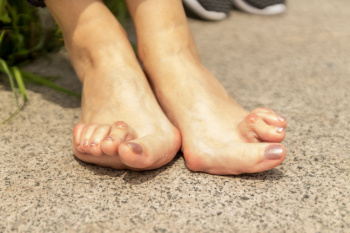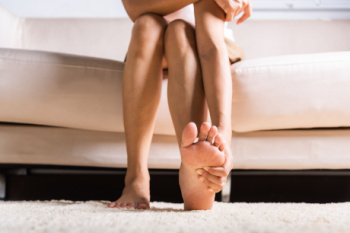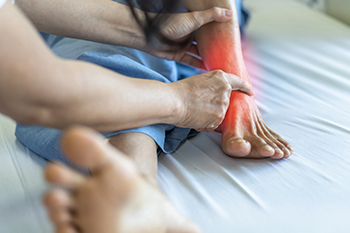February 2024
Ankle Fractures Can Involve Tendons and Nerves

Ankle fractures are common and often result from twisting or slipping. Understanding ankle anatomy can help diagnose and treat injuries. Ligaments, tendons, nerves, and arteries are involved. Podiatrists assess ankle injuries by checking for swelling, bruising, and weight-bearing ability. Treatment involves stabilizing the ankle with splints, reducing pain and swelling with rest and elevation, and managing discomfort with pain relievers. Severe injuries, such as dislocations or open fractures, require immediate medical attention. Proper care promotes faster healing and reduces long-term complications. If you have injured your ankle, it is suggested that you schedule an appointment with a podiatrist to obtain a proper diagnosis and appropriate treatment.
Broken ankles need immediate treatment. If you are seeking treatment, contact Dr. Michael A. Wood from Foot Health Institute. Our doctor can provide the care you need to keep you pain-free and on your feet.
Broken Ankles
A broken ankle is experienced when a person fractures their tibia or fibula in the lower leg and ankle area. Both of these bones are attached at the bottom of the leg and combine to form what we know to be our ankle.
When a physician is referring to a break of the ankle, he or she is usually referring to a break in the area where the tibia and fibula are joined to create our ankle joint. Ankles are more prone to fractures because the ankle is an area that suffers a lot of pressure and stress. There are some obvious signs when a person experiences a fractured ankle, and the following symptoms may be present.
Symptoms of a Fractured Ankle
- Excessive pain when the area is touched or when any pressure is placed on the ankle
- Swelling around the area
- Bruising of the area
- Area appears to be deformed
If you suspect an ankle fracture, it is recommended to seek treatment as soon as possible. The sooner you have your podiatrist diagnose the fracture, the quicker you’ll be on the way towards recovery.
If you have any questions, please feel free to contact one of our offices located in Lansing, and Chicago, IL . We offer the newest diagnostic and treatment technologies for all your foot care needs.
Common Symptoms of Rheumatoid Arthritis in the Feet

Rheumatoid arthritis, or RA, is a chronic autoimmune disorder that can affect various joints in the body, including those in the feet. Recognizing the common symptoms of RA in the feet is vital for early diagnosis and management. Individuals with RA may experience persistent pain, swelling, and stiffness in the affected joints, particularly in the toes, ankles, and midfoot. Morning stiffness lasting for more than an hour upon waking is a hallmark symptom of RA and can significantly impact mobility and daily activities. As the condition progresses, individuals may notice joint deformities, such as bunions, hammertoes, or claw toes, due to the erosion of cartilage and bone. Additionally, RA can cause inflammation of the tendons and ligaments in the feet, leading to tendonitis and difficulty walking. Numbness and tingling sensations in the feet may also occur as a result of nerve compression or inflammation. If you have RA and are experiencing symptoms in your feet, it is suggested that you are under the care of a podiatrist who can help you to successfully manage this condition.
Because RA affects more than just your joints, including the joints in your feet and ankles, it is important to seek early diagnosis from your podiatrist if you feel like the pain in your feet might be caused by RA. For more information, contact Dr. Michael A. Wood of Foot Health Institute. Our doctor will assist you with all of your podiatric concerns.
What Is Rheumatoid Arthritis?
Rheumatoid Arthritis (RA) is an autoimmune disorder in which the body’s own immune system attacks the membranes surrounding the joints. Inflammation of the lining and eventually the destruction of the joint’s cartilage and bone occur, causing severe pain and immobility.
Rheumatoid Arthritis of the Feet
Although RA usually attacks multiple bones and joints throughout the entire body, almost 90 percent of cases result in pain in the foot or ankle area.
Symptoms
- Swelling and pain in the feet
- Stiffness in the feet
- Pain on the ball or sole of feet
- Joint shift and deformation
Diagnosis
Quick diagnosis of RA in the feet is important so that the podiatrist can treat the area effectively. Your doctor will ask you about your medical history, occupation, and lifestyle to determine the origin of the condition. Rheumatoid Factor tests help to determine if someone is affected by the disease.
If you have any questions please feel free to contact one of our offices located in Lansing, and Chicago, IL . We offer the newest diagnostic and treatment technologies for all your foot and ankle needs.
Custom Orthotics For Seniors

Age gracefully and move freely with Custom Orthotics. For seniors seeking to maintain their independence, Custom Orthotics offer the stability and comfort essential for daily activities. Custom-tailored to your feet, they provide support, reduce pain, and enhance mobility, ensuring you're always on sure footing. Don't let age-related foot concerns hold you back. With Custom Orthotics, embrace every golden moment with confidence. Call today to schedule an appointment.
Benefits of Custom Orthotics

Orthotics encompass a diverse range of solutions. Custom orthotic inserts, prescribed by podiatrists, cater to individual needs, providing numerous benefits. One significant advantage is pain management. Orthotics are effective in managing pain arising from injuries, arthritis, or surgery. They offer support, relieve pressure on arthritic joints, and can replace or complement pain relievers, contributing to natural pain relief. Moreover, the portability of custom orthotic inserts is a notable feature. They are discreet and concealed within footwear. Orthotics also offer essential injury protection. They create a stable surface, guarding against sprains, fractures, and overuse injuries. They provide support, cradling the feet's contours, and reducing strain and risk. Enhanced activity is another benefit, as orthotics boost confidence and enable individuals to engage in activities they once avoided due to discomfort or deformities. Instead, orthotics facilitate an active lifestyle by preventing injuries and discomfort. Finally, custom orthotics provide a perfect fit tailored to a person's unique needs, considering factors like shoe type, health conditions, and lifestyle. This tailored approach offers a superior solution compared to generic, prefabricated inserts. If you would like to learn more about custom-made orthotics, it is suggested that you make an appointment with a podiatrist who can discuss this further with you.
Custom orthotics and shoe inserts are not just for cushioning the soles; they are about supporting the foundation of our body - our feet. The advantages extend far beyond immediate relief from discomfort. These personalized solutions, that Our doctor can prescribe, can significantly impact a person’s posture, alleviate pain in various parts of the body, and even enhance athletic performance.
As we lace up our shoes each day, having the right support can make a world of difference. Custom orthotics are like tailored suites for our feet, offering a bespoke solution to address our unique biomechanical needs. They provide stability where it is lacking, correct imbalances, and ensure that every step is a confident and pain-free one.
Custom orthotics and shoe inserts offer long-term health benefits. By addressing issues such as overpronation or underpronation, heel pain, plantar fasciitis, etc. orthotics can help prevent injuries and mitigate the progression of existing conditions. It’s an investment not just in the present, but in the future health of your feet and consequently, your overall well-being.
If you have any questions please contact one of our offices located in Lansing, and Chicago, IL . We offer the newest diagnostic and treatment technologies for all your foot and ankle needs.
Types of Tendonitis in the Foot

Tendonitis, inflammation, and irritation of tendons are common causes of foot pain. Tendonitis can lead to acute pain, swelling, and tenderness that may inhibit mobility. Various types of foot tendonitis can occur, each with distinct characteristics and causes. Achilles tendonitis, for instance, affects the Achilles tendon, commonly occurring a few inches above the heel where the tendon is weakest. Extensor tendonitis involves inflammation of tendons running along the top of the foot, often the result of friction from wearing ill-fitting footwear, particularly affecting individuals with high arches. Flexor tendonitis, prevalent among dancers and those requiring frequent toe balancing, induces deep ankle pain near the inner foot. Peroneal tendinosis, affecting tendons wrapping around the outer foot and ankle, leads to pain and swelling. Posterior tibial tendonitis, commonly associated with flat feet, causes pain and swelling along the inside of the foot due to inflammation of the tibialis posterior muscle tendon. An effective treatment plan may involve rest, orthotics, or other interventions. If you are experiencing pain from any foot-related tendonitis, it is suggested that you schedule an appointment with a podiatrist for an exam, diagnosis, and treatment options.
Foot Pain
Foot pain can be extremely painful and debilitating. If you have a foot pain, consult with Dr. Michael A. Wood from Foot Health Institute. Our doctor will assess your condition and provide you with quality foot and ankle treatment.
Causes
Foot pain is a very broad condition that could be caused by one or more ailments. The most common include:
- Bunions
- Hammertoes
- Plantar Fasciitis
- Bone Spurs
- Corns
- Tarsal Tunnel Syndrome
- Ingrown Toenails
- Arthritis (such as Gout, Rheumatoid, and Osteoarthritis)
- Flat Feet
- Injury (from stress fractures, broken toe, foot, ankle, Achilles tendon ruptures, and sprains)
- And more
Diagnosis
To figure out the cause of foot pain, podiatrists utilize several different methods. This can range from simple visual inspections and sensation tests to X-rays and MRI scans. Prior medical history, family medical history, and any recent physical traumatic events will all be taken into consideration for a proper diagnosis.
Treatment
Treatment depends upon the cause of the foot pain. Whether it is resting, staying off the foot, or having surgery; podiatrists have a number of treatment options available for foot pain.
If you have any questions, please feel free to contact one of our offices located in Lansing, and Chicago, IL . We offer the newest diagnostic and treatment technologies for all your foot care needs.
Foot and Ankle Injuries Among Assembly Line Workers

Jobs that require prolonged standing and walking often lead to complaints of foot and ankle pain among employees. Various factors contribute to foot and ankle pain in assembly line work, including time spent standing, walking, or sitting. Additionally, floor surface characteristics, weight, BMI, age, foot biomechanics, and demographic and medical history may significantly contribute to developing foot and ankle pain. Increased risk factors can include high metatarsal pressure during gait assessment, extended periods of walking, female gender, job dissatisfaction, and a history of conditions like rheumatoid arthritis, osteoporosis, or vascular disorders. Truck and forklift drivers who frequently exit and enter their vehicles tend to have a higher prevalence of ankle and foot problems. Prevention includes the use of shoe orthotics with medial longitudinal arch and metatarsal pad support. The incorporation of sit and stand work stations are also options to mitigate foot and ankle issues in these types of environments. If you are involved in assembly line work and experience foot or ankle pain, it is suggested that you schedule an appointment with a podiatrist for an exam and treatment that can help relieve pain.
Foot and ankle trauma is common among athletes and the elderly. If you have concerns that you may have experienced trauma to the foot and ankle, consult with Dr. Michael A. Wood from Foot Health Institute. Our doctor will assess your condition and provide you with quality foot and ankle treatment.
Foot and ankle trauma cover a range of injuries all over the foot; common injuries include:
- Broken bones
- Muscle strains
- Injuries to the tendons and ligaments
- Stress fractures
Symptoms
Symptoms of foot and ankle injuries vary depending on the injury, but more common ones include:
- Bruising
- Inflammation/ Swelling
- Pain
Diagnosis
To properly diagnose the exact type of injury, podiatrists will conduct a number of different tests. Some of these include sensation and visual tests, X-rays, and MRIs. Medical and family histories will also be taken into account.
Treatment
Once the injury has been diagnosed, the podiatrist can than offer the best treatment options for you. In less severe cases, rest and keeping pressure off the foot may be all that’s necessary. Orthotics, such as a specially made shoes, or immobilization devices, like splints or casts, may be deemed necessary. Finally, if the injury is severe enough, surgery may be necessary.
If you have any questions, please feel free to contact one of our offices located in Lansing, and Chicago, IL . We offer the newest diagnostic and treatment technologies for all your foot care needs.




